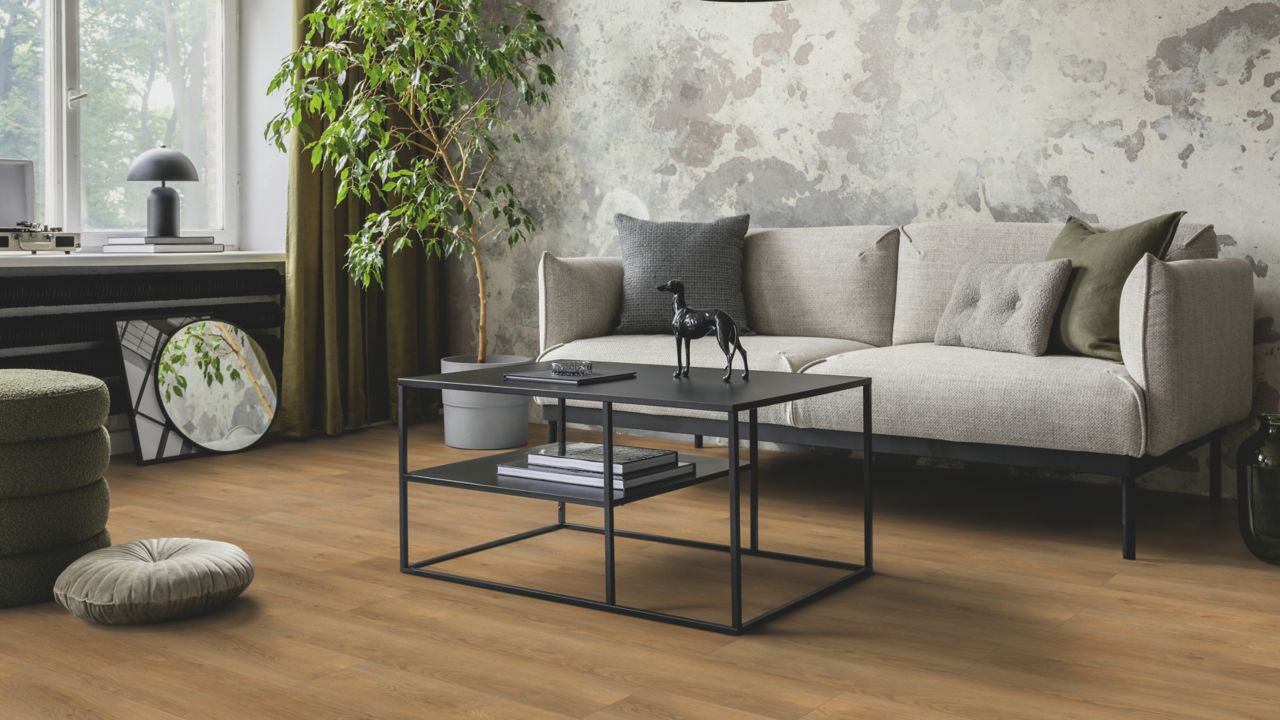Laminate Flooring Buying Guide
Laminate flooring is a popular and cost-effective option for homeowners who want the look of hardwood without the associated cost and maintenance. Known for its durability and versatility, laminate flooring can be installed in most rooms in your house.
In this article, we will help you understand what laminate flooring is, factors to consider before purchasing, and answers to common questions about laminate flooring.
What is Laminate Flooring?
Laminate flooring is a synthetic flooring material composed of multiple layers fused together through a lamination process. It typically consists of four layers:
- Wear Layer, a transparent protective layer that resists scratches, stains and fading.
- Design Layer, a high-resolution image that replicates the appearance of wood.
- Core Layer, a high-density fiberboard (HDF) that provides strength and stability.
- Backing Layer, a moisture-resistant layer that prevents warping and adds durability.
Unlike traditional hardwood, laminate flooring does not require sanding or refinishing, making it a low-maintenance option for busy households. It is also resistant to fading from sunlight exposure, making it ideal for rooms with large windows or high natural light.
Laminate flooring is also easy for any DIYer to install. Many laminate flooring options come with a click-lock system, allowing for simple installation without the need for glue or nails. This makes it an excellent choice for homeowners who want to update their flooring without needing to hire a professional.
Factors to Consider When Buying Laminate Flooring
Wear Layer Thickness
The thickness of the wear layer will help you determine the durability of laminate flooring. Thicker wear layers offer better resistance to scratches and damage, making them ideal for high-traffic areas. Thickness options generally range from 6mm to 20mm, with thicker options providing better sound absorption and a more solid feel underfoot. A thicker laminate also helps mimic the natural feel of hardwood flooring and can contribute to a more comfortable walking experience.
AC Rating
The Abrasion Class (AC) rating measures the durability of laminate flooring. Ratings range from AC1 to AC5, with higher numbers indicating greater resistance to wear and tear:
AC1: Best for low-traffic areas like bedrooms.
AC2: Suitable for moderate foot traffic in living rooms and dining areas.
AC3: Great for high-traffic residential spaces such as kitchens and hallways.
AC4: Designed for homes and light commercial use, such as small offices.
AC5: Best for any room in your home as well as busy commercial areas, including shopping centers and offices.
Choosing the right AC rating ensures your flooring withstands daily wear and lasts as long as possible. All Tile Shop laminate flooring options are rated AC5, so you can install the laminate flooring that best suits your project with confidence that it will stand up to scuffs, scratches and other marring that comes with daily use.
Look
Laminate flooring comes in a wide variety of styles and finishes, designed to emulate the natural beauty of hardwood flooring. Our laminate planks are available in a wide variety of looks that span from light grays and blondes to dark, rich caramel and mocha tones.
Darker laminate flooring is a good choice for creating a sense of warmth, elegance and sophistication. However, it can also make small rooms feel crowded, especially if the overall scheme of the room already trends dark.
Lighter laminate flooring is great for creating a bright and airy atmosphere. It reflects light well and can make smaller rooms feel larger and more open. It is also great for use as a neutral backdrop for bolder colored furniture and décor, but is not generally known for making a striking statement on its own.
Width
When deciding between types of laminate flooring, plank width is an important consideration, as it affects the overall aesthetic of a room. Narrow planks (3 to 5 inches) create a traditional look, while wider planks (6 to 8 inches) provide a modern, open feel. Wider planks also minimize the number of seams, giving the flooring a more continuous appearance. Room size can also influence your choice—wider planks can make small spaces feel larger, while narrower planks can create a sense of cohesion in larger spaces.
Finish Type
Laminate flooring comes in different finishes to accentuate the wood grain look and match your desired aesthetic. The Tile Shop’s laminate flooring comes in three finishes:
- High gloss finish that reflects light and provides a polished look.
- Matte finish, which reduces glare and offers a natural wood appearance.
- Textured finish that mimics real wood grain and enhances slip resistance.
Laminate Flooring Patterns
Laminate flooring can be installed in various patterns to match your exact design vision. Some popular options include:
- Straight pattern, where planks are installed in a simple, linear fashion for a clean look.
- Diagonal pattern, with planks laid at a 45-degree angle to the walls to add visual interest.
- Herringbone pattern, a sophisticated zigzag pattern that adds elegance and depth.
- Chevron pattern, which is similar to herringbone but with a continuous V-shaped design.
If you are looking for more flooring design inspiration, make sure to check out our kitchen flooring ideas article.
Budgeting
The cost for laminate flooring materials spans a wide range depending on laminate flooring thickness, AC rating and water resistance. Homeowners can expect to pay between $2 and $10 per square foot for laminate flooring, although it is possible to find options above and below that range. Installation costs are another factor, with professional installation typically running between $5 and $10 per square foot, depending on your region.
Opting for DIY installation is one way to save money on a laminate flooring installation project. Laminate flooring is designed for easy installation, making it a popular choice for DIY enthusiasts. If you do decide to install your own laminate flooring, be sure to carefully read the manufacturer's instructions and warnings and closely follow installation directions to prevent costly mistakes.


